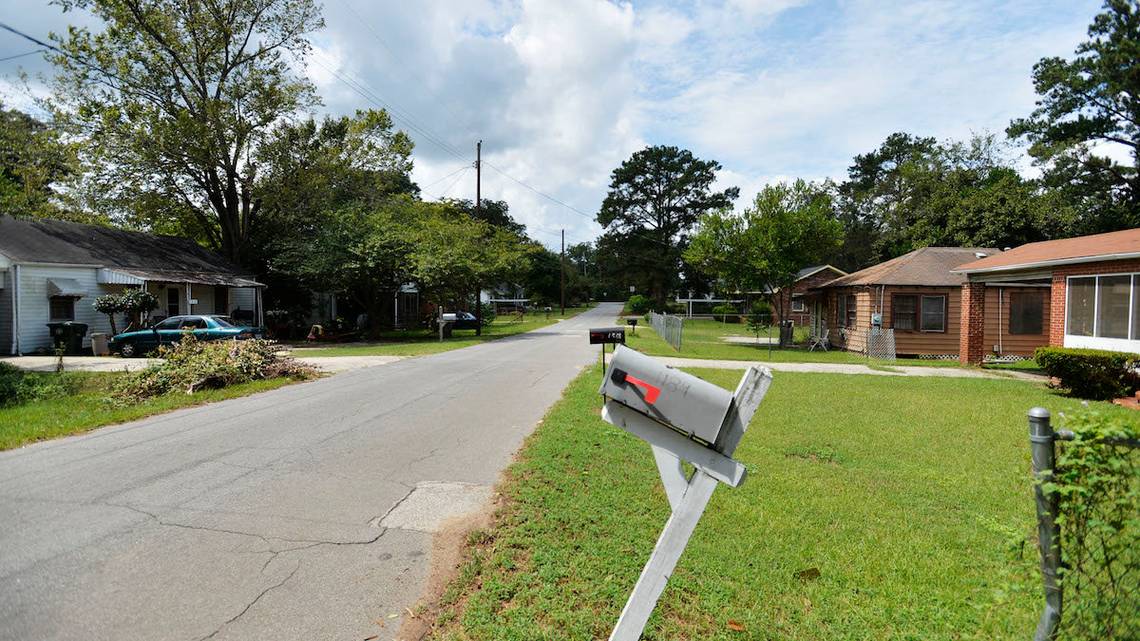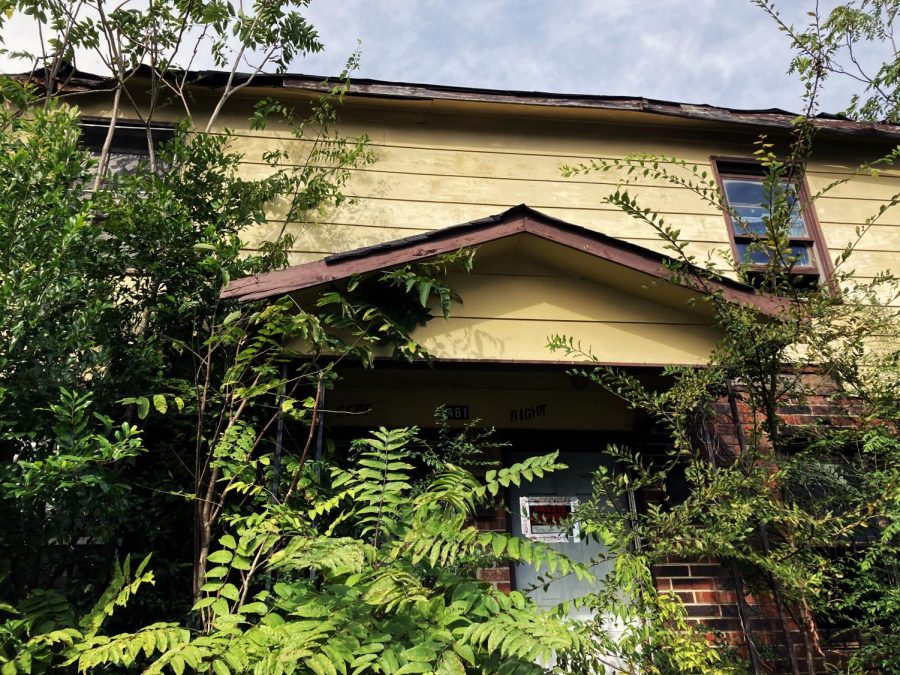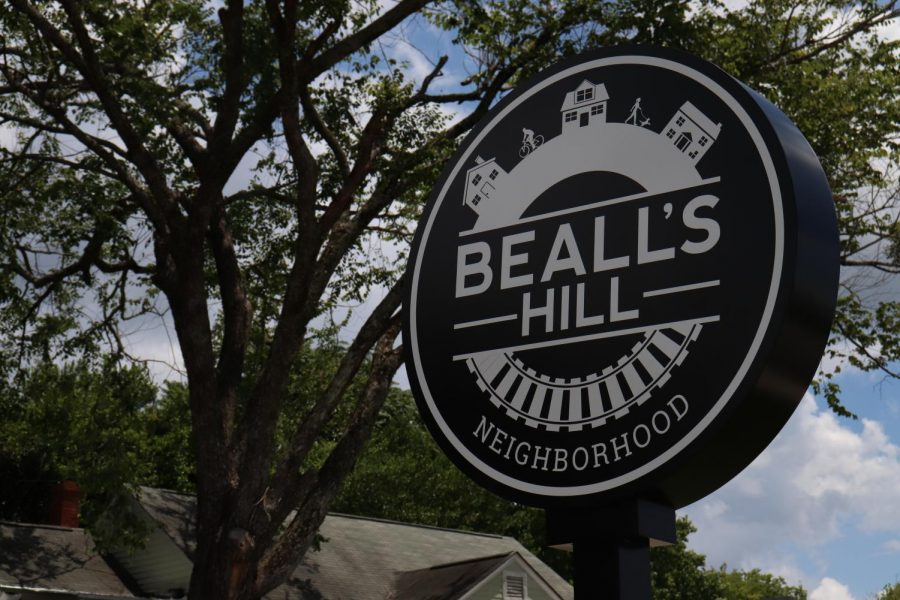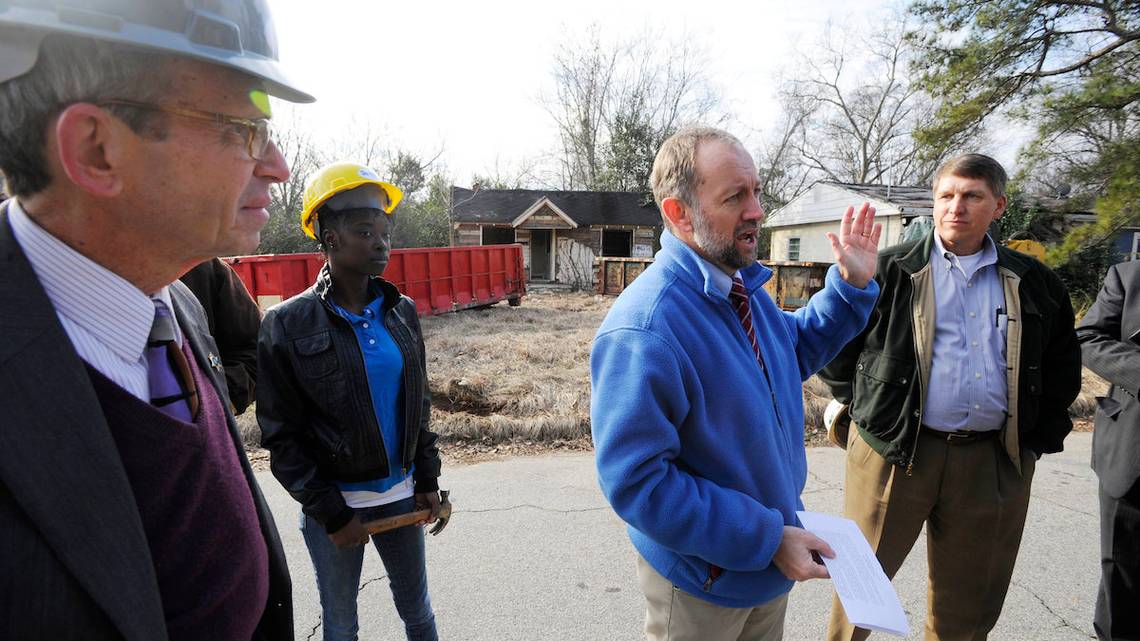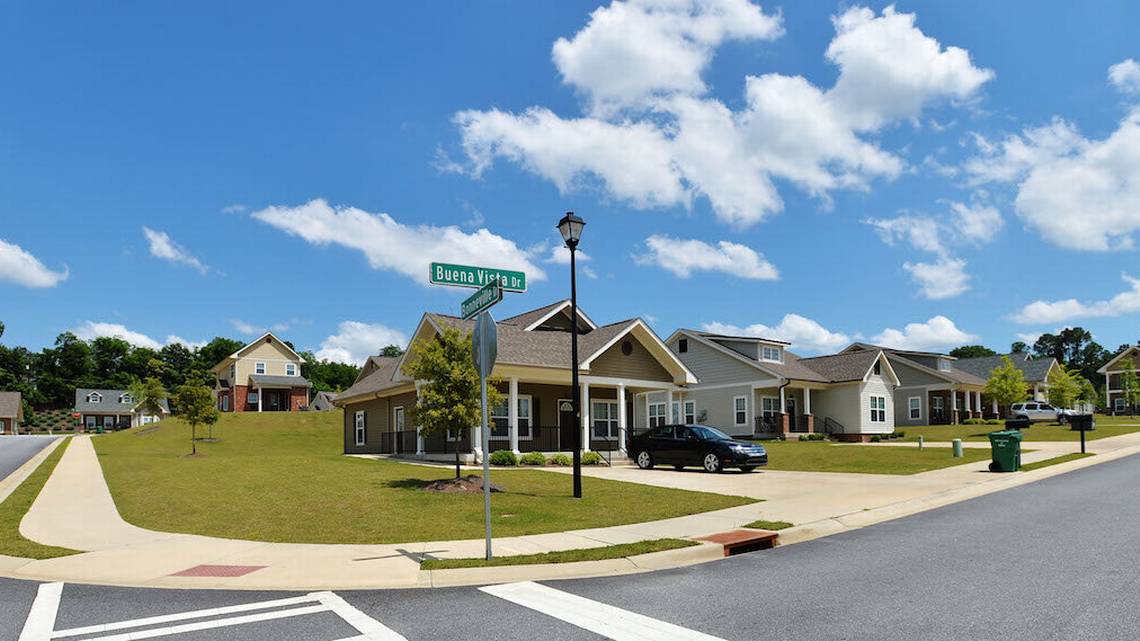You can almost coast the three miles to the bottom of Macon.
Houston Avenue, in a long, lazy slope below Eisenhower Parkway, parallels Interstate 75 half a mile or so to its west and drops 170 feet in elevation before it splits the southern ends of Broadway and Pio Nono Avenue.
The faded stretch south of Eisenhower is home to, among others, a boarded-up Trust Co. bank, Speedee Cash, a Family Dollar, Fincher’s Barbecue, Bruce Elementary School and enough abandoned storefronts to start a ghost town.
It is a pothole of its mid-20th-century self when it bustled as U.S. 41. Its once-thriving business district — where tourist camps, the motels of the day, dotted the landscape — has gone downhill since the 1960s and ‘70s. The easy explanation is that when the interstate shoved through in the late ‘60s, traffic raced for the freeway and commerce stalled.
Since then, on forgotten lanes along the corridor, ones like Hartley Street, which intersects Houston Avenue about midway between Rocky Creek and Guy Paine roads, generations of residents have come and gone.
The neighborhoods left behind have become breeding grounds for blight. Stately brick houses, and even not-so-grand ones, formerly havens for the middle class, have fallen into disrepair. Their upkeep is an afterthought to those who can barely afford the rent.
Until 1940, Hartley Street boasted only three or four houses. It was a dirt road at the edge of town, just outside the city limits. Now it lies in the heart of a gritty swath that reaches south and east from Rocky Creek Road’s I-75 interchange over beyond Broadway and down to the Guy Paine industrial area.
If you didn’t know better, you might think Macon began there. But the tail end of Houston Avenue, decrepit as it may seem, isn’t as old as it looks.
It boomed residentially in the 1940s and ‘50s, after Robins Air Force Base opened. Government workers needed places to live. Houses sprouted on Hartley Street and on brand-new streets to the south. Old-timers there say the homes were built on the cheap and in a hurry — sometimes in a matter of days.
They weren’t exactly made to last, either, and yet here they are — 50, 60, 70 years on — falling apart with little hope of being put back together.
Today there are two dozen houses on Hartley Street, the average one worth less than $20,000. A quarter sit empty. Seventeen are rentals. There are uglier and more poverty-wracked streets in Macon, but Hartley Street sits in a pocket of the city that is on the verge of becoming an irreparable eyesore.
A young woman whose family rents one of the oldest houses on Hartley, one built in 1924, relies on the run-down rental’s warts when she tells visitors how to get there.
“I tell them I’m in the dirty-looking white house with the white picket fence.”
Jake T. Stancile, 87, spent his teenage years in that house. It was far enough in the sticks then that his father, Doyle, could land his Piper Cub airplane in the empty field out front. Annie Pitts, an old woman who lived down the street, raised cows, hogs, chickens.
“When she cooked collards, you could smell them clean up to my house,” Jake Stancile recalled.
His father was proprietor of Stancile’s Drive-In Restaurant on Houston Avenue. It was once an around-the-clock eatery, one of the few places in town you could get a sirloin steak. Entertainers, politicians and bigwigs dropped in: Johnny Cash, June Carter, Tex Ritter, Herman Talmadge, south Florida businessmen with Miami beauty queens on their arms.
In 1939, Doyle Stancile, according to property records, bought the late-’20s-era Hartley Street house a block and a half south of the restaurant for $1,800.
Five years ago, the place went for $7,700.
But Jake Stancile, a railroad clerk, and his family were long gone by then. Doyle had died in 1957, Macon soon annexed the neighborhood and the Stanciles wanted no part of city life. They sold the house in the mid-1960s — the sale price wasn’t recorded in deed books — and moved to rural Crawford County.
When he ventures back to Hartley Street, Stancile said, all he sees is despair.
“I’m telling you, it’s awful,” he said, sitting at his kitchen table in a block house that overlooks a catfish pond. “We got the hell out.”
As depressed locales metastasize and lower-income residents move in, the poor are often less able or inclined to maintain their homes and yards.
Justin B. Hollander, a professor of urban planning at Tufts University in Massachusetts, has studied the plight of abandoned communities.
“Where people used to plant flowers and paint every three or four years,” Hollander said, “now they paint their houses every 10 years, and they don’t plant flowers.”
Another factor is the unavoidable coming and going of tenants. Homeowners, on average, move every seven years. Renters move more often.
“People are always on the go,” Hollander said. “You can’t have a neighborhood that nobody’s ever going to leave. … The question is, ‘Who are the people who are gonna come and replace them?’ If the neighborhood maintains its attractiveness exactly as it was before, … then basically the same kind of people. … But what is typical is just the opposite, that kind of a lower strata of society ends up moving in.”
Hollander advocates demolishing abandoned houses to make way for parks and green space, which can help neighborhoods regain their footing.
“Just because a place starts to look bad and starts to look run-down doesn’t make it qualitatively a bad place. It just needs some attention,” he said.
And no matter how awful a neighborhood may appear to outsiders, Hollander said there is some research that shows how residents in some of the most decayed places still rate their surroundings favorably. “People will say, ‘This is mine, and I know it. … It’s home.’ ”
Hartley Street is a few hundred yards long. It runs west of Houston Avenue from an assisted-living home with an old chapel beside it, a steeple bell visible through a square window at its base.
One Thursday morning in early June, a jittery young man who lives near that end of the street, the east end, answers his door and said, “I’m good.” He waves away a visitor, says he has no interest in discussing the state of the neighborhood.
A couple of doors down, at a brick house with a maroon wheelchair ramp leading to an azalea- and camellia-lined porch shaded by a pecan tree, 57-year-old Ann Hall stepped outside when the doorbell rings.
Her mother, Mary, bought the place 30 years ago. Hall, now on disability, moved in after her mom died but was there most every day since the mid-1980s. She has seen the street’s decline firsthand. Renters nearby, she said, recently ripped the flooring and wiring out of a house.
“Ridiculous,” Hall said. “People don’t take care of stuff. It’s like they don’t care.” “But,” she added, “when you’ve bought a house here, you can’t just say, ‘OK, I gotta go.’ … You’ve got bills, you’ve got to eat, and to try to move somewhere better costs so much more.”
Her cousin, Gloria Watts, lives next door in one of the street’s original homes. Its brick-columned piazza overlooks dogwoods and lawn worn to dirt by the previous renters, who parked on it.
“I keep saying I’m gonna plant me some grass,” said Watts, 58. She moved there from her native Sandersville three years ago. Sometimes she misses home, the country. “It’s kind of run-down here,” Watts, a former nurse assistant, said, “but this is what I can afford.”
When she tells of her surroundings, the peeling paint, the weed-eaten yards, the disrepair, she thinks a moment before she speaks.
“You see it,” Watts said, “and you don’t see it.”
Next door at 1175 Hartley, at the “dirty white house” where Jake Stancile once lived, the young woman who stays there is inside.
A little boy playing in the yard trotted to fetch her.
Kenya Chappell, 23, whose mother rents the Section 8 house, said she moved here from Mississippi about four years ago. She isn’t sure what blight is.
“I feel like Macon is for people that got a lot of money, people that’s retired. It’s not a place for people to just come and live — unless you already live here,” Chappell said. She doesn’t like seeing abandoned houses and wishes more were bulldozed. But she has gotten used to the scenery.
“This is how I grew up,” Chappell said. “I never had the best of the best.”
The west end of Hartley Street is its most unsightly.
A rotting house in a brush-choked yard there has been targeted for demolition.
Behind it, along an unpaved road that connects it to Glendale Avenue a block north, a woman was attacked and killed by a pack of dogs in 2010.
In 1996, at an apartment complex that now sits mostly vacant and serves as Hartley’s dead end, a man was fatally shot. The slaying was never solved.
That said, the street is not crime-torn.
Robert Spence, 84, who lives across from the crumbling house, watches TV in his living room with his front door swung open.
“Sometimes when you lock up, you lose out on things,” he said. A chow mix named Pete keeps him company. “That’s my buddy. … He tells me everything I want to know about people coming,”
Spence said. For more than 50 years, Spence ran his own masonry company. He and his men laid the brick at the Bibb County jail. He moved into his $750-a-month Hartley Street rental in 2004. Spence knows the yard may look shabby, that the house could use a face-lift. On a scale of one to 10, he rates it about a four.
“I would go lower than that if I wasn’t living here. But I’ve got to speak up. I know it’s some good stuff over here, too,” he said. “It ain’t really a dump. Well, I thought it was a dump, until I moved over here.”
He thought about what he had said, then said, “I just hate to come over here. But I’m just too old to move. And I just don’t want to go to no nursing home. I’m set up right here. The rent man treat me nice.”
A week later, on a Friday in mid-June, Jake Stancile was back on Hartley Street.
A reporter had asked him to revisit the place, to reminisce.
Stancile, in slate slacks and a blue polo, ambled into his boyhood sporting a black fedora.
“Times sure have changed,” he said. T
he old barber shop on the corner? Gone. The grocery next door? History. He told of the houses on the south side of the street — prefabricated ones hauled in on trucks. He marveled at the tall loblollies.
“Wasn’t no such thing as a pine tree over here,” he said.
He spoke again of Annie Pitts, the woman whose collards once wafted through the neighborhood. She also tended dairy cows. “You could leave a bottle on your porch, and she’d put a full one there,” Stancile said. “Yeah, it’s been a long time ago.”
Not far from where Pitts’ place used to be, he pointed to a stand of trees.
“The little woods,” he calls them. He and his pals built a two-story tree house there. They’d climb up and smoke Kite tobacco that a buddy swiped from a nearby store. The neighborhood was peaceful in those days.
“Nobody bothered you. But it ain’t that way anymore,” he said. “They’d rob you every other week.”
At the boarded-up, red-brick wreck in the overgrown lot across from Robert Spence’s place, Stancile said, “That could be a nice house. Somebody done some good brickwork on it.”
A man from the county inspections department happened by in a car. The man made note of the ramshackle structure and drives on.
“I seen the light just in time,” Stancile said to himself. “I was the first one to move away.”
At the house he called home for 20 years, a man and woman sat on the porch. Told that Stancile lived there half a century ago, they didn’t mind if he looked around. Stancile admired the twin pecan trees in the front yard. He used to climb them and shake them.
“Best pecans in Georgia comes off them two trees right there,” he said, loud enough for the people on the porch to hear.
“We don’t get ‘em,” the woman said. “They don’t fall as much.”
Stancile eased into the side yard and noticed his old workshop out back. He thought about how worn out everything looks. Then he spotted another pecan tree, towering over his old shop. The tree is massive, its branches sprawling, lording over this small corner of south Macon. Stancile planted that tree when he was a boy, when it was no taller than he was. “Look,” he said, “look at it now.”



